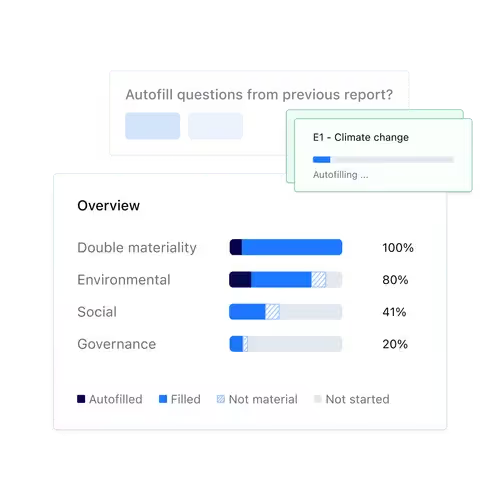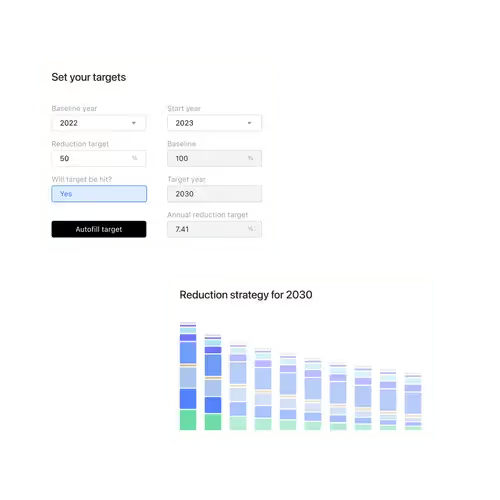Disclaimer: Latest EUDR developments
On 21 October, the European Commission proposed targeted changes to the EU Deforestation Regulation (EUDR). These adjustments aim to make the rollout smoother without changing the regulation’s overall goals.
Key points from the proposal:
We're closely monitoring the development and will update our content accordingly. In the meantime, read the full explainer here.
As environmental, social, and governance (ESG) performance becomes a key focus for investors, consumers, and regulators, finance teams face growing pressure to measure and report on these metrics effectively.
Spreadsheets, such as Excel, are the tool of choice for many, with a recent EY study revealing that 55% of finance executives still rely on spreadsheets to manage ESG data. Yet with data quality reportedly the biggest barrier to ESG investing, it's clear that legacy technology is failing to meet today’s stringent requirements.
Many forward-thinking finance teams are turning to sustainability reporting software to centralize, standardize, and verify the accuracy of ESG data. According to a 2024 survey by Workiva, 89% of companies plan to allocate budget towards ESG-related technology like this in the next three years.
Not only do these tools address the limitations of manual reporting, but they also open up new functionalities—from streamlined data aggregation to built-in reporting frameworks that align with regulations like the EU’s Corporate Sustainability Reporting Directive (CSRD).
So, how exactly is sustainability reshaping the role of finance professionals? What are the drawbacks of relying on spreadsheets for sustainability reporting? And how can sustainability reporting software address these challenges? Read on for everything you need to know.
As the gatekeepers of financial accounting and reporting, finance teams are increasingly stepping up to manage their companies’ ESG initiatives.
With a solid foundation in compiling and reporting detailed metrics, maintaining compliance, working across business functions, and overseeing third-party verification, these teams are perfectly positioned to lead their organizations' ESG efforts.
Given these critical responsibilities, choosing the right tool for the job is crucial—especially if your business falls under the scope of the CSRD. Besides convenience, ESG reporting tools reduce the risk of non-compliance and free up time to focus on more important things (rather than being bogged down managing spreadsheets).
{{custom-cta}}
While spreadsheets no doubt serve some valuable functions, they come with limitations finance teams should not ignore. Here are some of the top reasons why you should avoid using spreadsheets for sustainability reporting:
ESG reporting requires collecting data from a multitude of internal and external sources. In most cases, these sources aren’t linked, with a recent EY study revealing 60% of finance executives are dealing with ESG data scattered across a patchwork of unconnected applications.
If you’re tackling this within spreadsheets, the chance of errors goes up significantly. Plus, manually verifying that all data is complete, accurate, and formatted consistently is time consuming and inefficient.
Spreadsheets lack advanced features for automating tasks such as reporting. Not only does this increase the manual workload, but it also limits the timeliness and auditability of reports—both of which are crucial elements of ESG reporting.
As your sustainability reporting progresses, so too will the amount of data you gather. With Excel limited to 1,048,576 rows and 16,384 columns, there will come a time where your dataset simply exceeds the limit of traditional spreadsheets. Not to mention the time it would take to work in such a large file…
Emission factors, reporting boundaries, regional conversions… tackling all this manually in spreadsheets requires a great deal of expertise with formulas and a lot of time. It can also limit your ability to derive meaningful insights from your data and pick up on important trends or predictions.
We’ve all been there—that sinking feeling you get when you realize your Excel file has been corrupted, deleted, or overwritten. Whether due to too many people working in the same file or a mysterious accident, recovering lost data can be challenging, if not impossible.
Take the Excel error during the Covid-19 pandemic that led to nearly 16,000 positive cases in England going unreported.
Research shows that 88% of all spreadsheets contain at least one error. No matter how careful you are, manually entering, updating, and managing sustainability data in spreadsheets greatly increases the risk of errors—whether unintentional or deliberate.
A simple typo, incorrect formula, or misplaced decimal point can lead to major discrepancies in your reporting or analysis, ultimately impacting decision-making and strategic planning. Plus, without a clear audit trail, there’s no way to trace the origin of these mistakes.

Regulatory compliance is a big commitment, with little to no margin for error. Take the CSRD, for example, composed of around 500 KPIs and 10,000 data points that all need to be meticulously tracked and reported.
Besides the sheer volume of data to be collected, the CSRD also requires data to be in XHTML format, and tagged according to a new digital categorization system. Data must also be audit-proof to meet the directive’s mandatory limited assurance requirement.
Plus, with sector- and SME-specific standards still in development, companies will need to adapt their reporting strategies (and their spreadsheets) when the new standards are released. Given these complex requirements, managing all the intricacies in spreadsheets is simply not feasible and leaves a lot of room for error, inefficiency, and risk.
Sustainability reporting is intricate and demands more than just basic tools. Here’s a comparison between the capabilities of sustainability software and traditional spreadsheets:
Collecting data from Scope 1, 2 and 3 emissions and manually aggregating it in spreadsheets is time-consuming and error-prone.
Sustainability reporting software automatically integrates data from multiple sources like Excel and accounting software. This reduces manual effort and the likelihood of errors while ensuring data consistency and completeness.
Carbon accounting is a complex process that requires aligning raw spend- or activity-based data with appropriate emissions factors. Relying solely on spreadsheets for this task can lead to mistakes. In fact, a study by Boston Consulting Group revealed error rates of 30-40% in emissions calculations.
Sustainability reporting software offers more precise and sophisticated measurement techniques. It aligns data with the latest verified emission factors and the Greenhouse Gas Protocol (GHG Protocol), significantly reducing errors and improving report reliability.
Analyzing complex sustainability data in spreadsheets can lead to inconsistencies and limited insights. Software like Coolset delivers up to 60% more insights than traditional methods. This gives finance teams a deeper understanding of current data and the ability to forecast future trends, which is crucial for strategic planning.
{{product-tour-injectable}}
Maintaining compliance in spreadsheets can be a struggle due to the manual nature of updating data and adhering to complex regulatory requirements.
Sustainability reporting software is specifically designed to ensure compliance with common environmental regulations like GHG Protocol and CSRD. It also automatically updates to reflect regulatory changes, helping you remain compliant over time.
Producing reports from spreadsheets can be time consuming, with a high risk of inaccuracies and non-compliance.
Sustainability software streamlines the reporting process, offering customizable, prefilled templates that comply with international standards. It automatically generates detailed, auditable reports in a variety of formats based on your needs.
While spreadsheets will likely remain part of your toolkit, it’s clear they fall short as a standalone solution for modern sustainability reporting.
Opting for sustainability reporting software over traditional spreadsheets can significantly enhance the accuracy and efficiency of your reporting, ultimately driving successful ESG initiatives.
Tools like Coolset offer a comprehensive solution that addresses the limitations of spreadsheets. Our platform not only streamlines data collection and analysis but also ensures accuracy and compliance across all levels of reporting. This helps finance teams to effectively quantify sustainability metrics, empowering organizations to make informed, strategic decisions based on reliable and timely ESG data.
Say goodbye to the limitations of spreadsheets and embrace the power of sustainability reporting software with Coolset. Request a demo today to see how you can transform your company’s ESG reporting.
Transform your company's ESG reporting with Coolset.

Transform your mid-market company's ESG reporting with Coolset.
